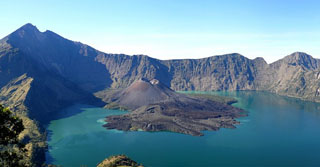Report on Rinjani (Indonesia) — 28 April-4 May 2010
Smithsonian Institution / US Geological Survey
Weekly Volcanic Activity Report, 28 April-4 May 2010
Managing Editor: Sally Sennert.
Please cite this report as:
Global Volcanism Program, 2010. Report on Rinjani (Indonesia) (Sennert, S, ed.). Weekly Volcanic Activity Report, 28 April-4 May 2010. Smithsonian Institution and US Geological Survey.
Rinjani
Indonesia
8.42°S, 116.47°E; summit elev. 3726 m
All times are local (unless otherwise noted)
CVGHM reported that observers at a post located 12.5 km NE of Rinjani saw one whitish-colored plume that rose 100 m from the volcano during February. Dense whitish plumes (and possibly brown) rose 500-900 m in March on 26 occasions and as high as 1,500 m in April on 41 occasions. Plumes seen on 1 and 2 May were "chocolate" in color and rose a maximum height of 1,600 m. From February through April seismicity decreased, although the maximum amplitude of earthquakes increased. CVGHM also noted that ash eruptions and ejected incandescent material fell within Rinjani caldera, but some ash was blown out of the caldera. The Alert Level was raised to 2 (on a scale of 1-4) on 2 May.
Geological Summary. Rinjani volcano on the island of Lombok rises to 3726 m, second in height among Indonesian volcanoes only to Sumatra's Kerinci volcano. Rinjani has a steep-sided conical profile when viewed from the east, but the west side of the compound volcano is truncated by the 6 x 8.5 km, oval-shaped Segara Anak (Samalas) caldera. The caldera formed during one of the largest Holocene eruptions globally in 1257 CE, which truncated Samalas stratovolcano. The western half of the caldera contains a 230-m-deep lake whose crescentic form results from growth of the post-caldera cone Barujari at the east end of the caldera. Historical eruptions dating back to 1847 have been restricted to Barujari cone and consist of moderate explosive activity and occasional lava flows that have entered Segara Anak lake.
Source: Pusat Vulkanologi dan Mitigasi Bencana Geologi (PVMBG, also known as CVGHM)

